Huajian Zhang
LNE-Blocking: An Efficient Framework for Contamination Mitigation Evaluation on Large Language Models
Sep 18, 2025Abstract:The problem of data contamination is now almost inevitable during the development of large language models (LLMs), with the training data commonly integrating those evaluation benchmarks even unintentionally. This problem subsequently makes it hard to benchmark LLMs fairly. Instead of constructing contamination-free datasets (quite hard), we propose a novel framework, \textbf{LNE-Blocking}, to restore model performance prior to contamination on potentially leaked datasets. Our framework consists of two components: contamination detection and disruption operation. For the prompt, the framework first uses the contamination detection method, \textbf{LNE}, to assess the extent of contamination in the model. Based on this, it adjusts the intensity of the disruption operation, \textbf{Blocking}, to elicit non-memorized responses from the model. Our framework is the first to efficiently restore the model's greedy decoding performance. This comes with a strong performance on multiple datasets with potential leakage risks, and it consistently achieves stable recovery results across different models and varying levels of data contamination. We release the code at https://github.com/RuijieH/LNE-Blocking to facilitate research.
Lost in Literalism: How Supervised Training Shapes Translationese in LLMs
Mar 06, 2025



Abstract:Large language models (LLMs) have achieved remarkable success in machine translation, demonstrating impressive performance across diverse languages. However, translationese, characterized by overly literal and unnatural translations, remains a persistent challenge in LLM-based translation systems. Despite their pre-training on vast corpora of natural utterances, LLMs exhibit translationese errors and generate unexpected unnatural translations, stemming from biases introduced during supervised fine-tuning (SFT). In this work, we systematically evaluate the prevalence of translationese in LLM-generated translations and investigate its roots during supervised training. We introduce methods to mitigate these biases, including polishing golden references and filtering unnatural training instances. Empirical evaluations demonstrate that these approaches significantly reduce translationese while improving translation naturalness, validated by human evaluations and automatic metrics. Our findings highlight the need for training-aware adjustments to optimize LLM translation outputs, paving the way for more fluent and target-language-consistent translations. We release the data and code at https://github.com/yafuly/LLM_Translationese.
Leveraging Entailment Judgements in Cross-Lingual Summarisation
Aug 01, 2024



Abstract:Synthetically created Cross-Lingual Summarisation (CLS) datasets are prone to include document-summary pairs where the reference summary is unfaithful to the corresponding document as it contains content not supported by the document (i.e., hallucinated content). This low data quality misleads model learning and obscures evaluation results. Automatic ways to assess hallucinations and improve training have been proposed for monolingual summarisation, predominantly in English. For CLS, we propose to use off-the-shelf cross-lingual Natural Language Inference (X-NLI) to evaluate faithfulness of reference and model generated summaries. Then, we study training approaches that are aware of faithfulness issues in the training data and propose an approach that uses unlikelihood loss to teach a model about unfaithful summary sequences. Our results show that it is possible to train CLS models that yield more faithful summaries while maintaining comparable or better informativess.
What Have We Achieved on Non-autoregressive Translation?
May 21, 2024
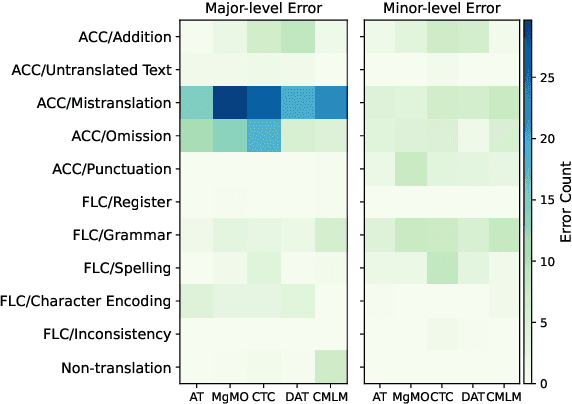


Abstract:Recent advances have made non-autoregressive (NAT) translation comparable to autoregressive methods (AT). However, their evaluation using BLEU has been shown to weakly correlate with human annotations. Limited research compares non-autoregressive translation and autoregressive translation comprehensively, leaving uncertainty about the true proximity of NAT to AT. To address this gap, we systematically evaluate four representative NAT methods across various dimensions, including human evaluation. Our empirical results demonstrate that despite narrowing the performance gap, state-of-the-art NAT still underperforms AT under more reliable evaluation metrics. Furthermore, we discover that explicitly modeling dependencies is crucial for generating natural language and generalizing to out-of-distribution sequences.
Fine-Grained Natural Language Inference Based Faithfulness Evaluation for Diverse Summarisation Tasks
Feb 27, 2024Abstract:We study existing approaches to leverage off-the-shelf Natural Language Inference (NLI) models for the evaluation of summary faithfulness and argue that these are sub-optimal due to the granularity level considered for premises and hypotheses. That is, the smaller content unit considered as hypothesis is a sentence and premises are made up of a fixed number of document sentences. We propose a novel approach, namely InFusE, that uses a variable premise size and simplifies summary sentences into shorter hypotheses. Departing from previous studies which focus on single short document summarisation, we analyse NLI based faithfulness evaluation for diverse summarisation tasks. We introduce DiverSumm, a new benchmark comprising long form summarisation (long documents and summaries) and diverse summarisation tasks (e.g., meeting and multi-document summarisation). In experiments, InFusE obtains superior performance across the different summarisation tasks. Our code and data are available at https://github.com/HJZnlp/infuse.
DiffYOLO: Object Detection for Anti-Noise via YOLO and Diffusion Models
Jan 03, 2024Abstract:Object detection models represented by YOLO series have been widely used and have achieved great results on the high quality datasets, but not all the working conditions are ideal. To settle down the problem of locating targets on low quality datasets, the existing methods either train a new object detection network, or need a large collection of low-quality datasets to train. However, we propose a framework in this paper and apply it on the YOLO models called DiffYOLO. Specifically, we extract feature maps from the denoising diffusion probabilistic models to enhance the well-trained models, which allows us fine-tune YOLO on high-quality datasets and test on low-quality datasets. The results proved this framework can not only prove the performance on noisy datasets, but also prove the detection results on high-quality test datasets. We will supplement more experiments later (with various datasets and network architectures).
Revisiting Cross-Lingual Summarization: A Corpus-based Study and A New Benchmark with Improved Annotation
Jul 08, 2023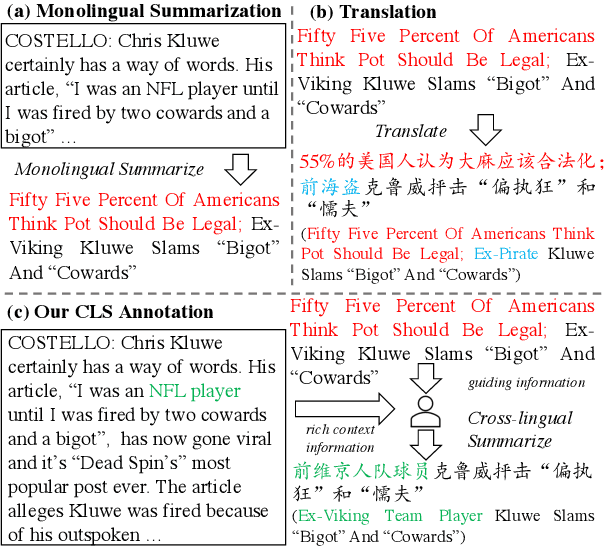
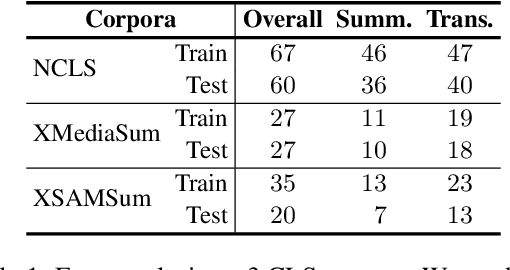
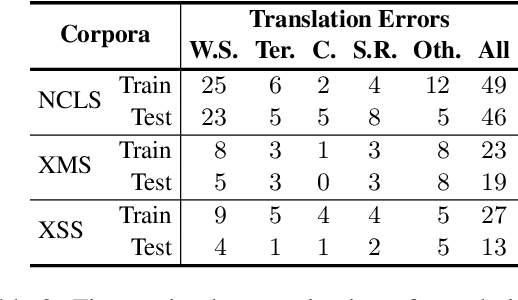
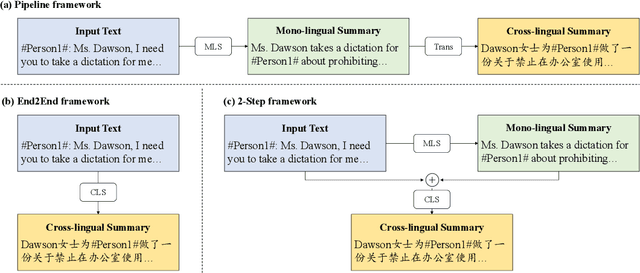
Abstract:Most existing cross-lingual summarization (CLS) work constructs CLS corpora by simply and directly translating pre-annotated summaries from one language to another, which can contain errors from both summarization and translation processes. To address this issue, we propose ConvSumX, a cross-lingual conversation summarization benchmark, through a new annotation schema that explicitly considers source input context. ConvSumX consists of 2 sub-tasks under different real-world scenarios, with each covering 3 language directions. We conduct thorough analysis on ConvSumX and 3 widely-used manually annotated CLS corpora and empirically find that ConvSumX is more faithful towards input text. Additionally, based on the same intuition, we propose a 2-Step method, which takes both conversation and summary as input to simulate human annotation process. Experimental results show that 2-Step method surpasses strong baselines on ConvSumX under both automatic and human evaluation. Analysis shows that both source input text and summary are crucial for modeling cross-lingual summaries.
Chain-of-Symbol Prompting Elicits Planning in Large Langauge Models
May 23, 2023



Abstract:In this paper, we take the initiative to investigate the performance of LLMs on complex planning tasks that require LLMs to understand a virtual spatial environment simulated via natural language and act correspondingly in text. We propose a benchmark named Natural Language Planning (NLP) composed of a set of novel tasks: Brick World, NLVR-based Manipulations, and Natural Language Navigation. We found that current popular LLMs such as ChatGPT still lack abilities in complex planning. This arises a question -- do the LLMs have a good understanding of the environments described in natural language, or maybe other alternatives such as symbolic representations are neater and hence better to be understood by LLMs? To this end, we propose a novel method called CoS (Chain-of-Symbol Prompting) that represents the complex environments with condensed symbolic spatial representations during the chained intermediate thinking steps. CoS is easy to use and does not need additional training on LLMs. Extensive experiments indicate that CoS clearly surpasses the performance of the Chain-of-Thought (CoT) Prompting in all three planning tasks with even fewer tokens used in the inputs compared with CoT on ChatGPT and InstructGPT. The performance gain is strong, by up to 60.8% accuracy (from 31.8% to 92.6%) on Brick World for ChatGPT. CoS also reduces the number of tokens in the prompt obviously, by up to 65.8% of the tokens (from 407 to 139) for the intermediate steps from demonstrations on Brick World.
 Add to Chrome
Add to Chrome Add to Firefox
Add to Firefox Add to Edge
Add to Edge